
Ethnic groups with a social structure based on lineage and strong allegiances to distant relatives show a greater propensity for violent conflict
In recent years, it has become clear that characteristics of pre-colonial African societies are an important determinant of their current economic development. Existing studies have tended to focus on the role of historical political centralisation, and have found a positive relationship between historical statehood and income today (Gennaioli and Rainer 2007, Michalopoulos and Pappaioannou 2013, 2014). However, there are many other differences across African societies beyond their levels of state centralisation. For example, groups also differ in terms of family structure, the importance and function of kinship networks, and the centrality of age as an organising force. Variation in these social institutions – many of which remain in force today – might also have important consequences for economic development.
Segmentary lineage in sub-Saharan Africa
One common social structure among ethnic groups in sub-Saharan Africa is segmentary lineage organisation. Segmentary lineage societies are characterised by the foremost importance of kin relationships in determining individuals’ social and political allegiances, as well as their patterns of residence.1 Several anthropologists have posited a direct link between segmentary lineage organisation and violent conflict (especially Evans-Pritchard 1940 and Sahlins 1961, but also Bohannon 1958, Kelly 1985, Lewis 1961, 1989, 1994, Salzman 2007). In particular, they argue that clearly defined allegiances based on genealogy make segmentary lineage societies well designed to mobilise combatants for conflict. To our knowledge, however, this relationship has never been studied systematically or empirically.
Consider the diagram in Figure 1 of a hypothetical (patrilineal) segmentary lineage society. Triangles represent men and each row represents a generation. All individuals descend from a common ancestor ‘I’ and are also members of smaller lineage segments with other individuals who are increasingly closely related to them. In Figure 1, if individual ‘i’ were to have a dispute with individual ‘ix,’ all individuals belonging to ‘Major Segment A’ would be allied with, and come to the defence of, individual ‘i.’ Similarly, all individuals in ‘Major Segment B’ would be allied with and come to the defence of individual ‘ix.’ Thus, a dispute between two individuals escalates into a dispute between two large communities, as individuals mobilise to support members of their lineage or lineage segment.
Figure 1
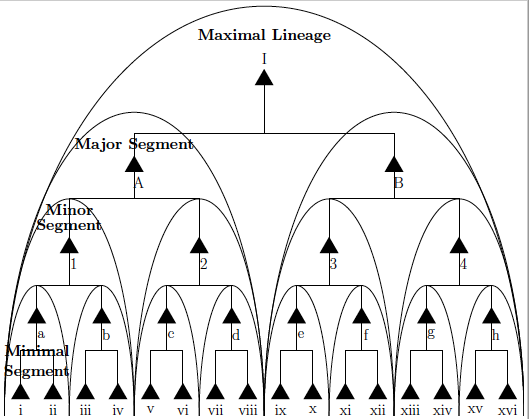
Evans-Pritchard (1940: 142) describes the way that the lineage system leads to conflict among the Nuer (a segmentary lineage society) in South Sudan: “The members of any segment [lineage section] unite for war against adjacent segments of the same order and unite with these adjacent segments against larger sections…Hostility between smaller segments of a tribe may involve the larger segments of which they form part [and] may thus…bring about a fight between secondary, and even primary, tribal sections.” A similar logic has been used by Lewis (1961, 1989, 1994) to explain the scale and duration of civil war in Somalia, which since 1991 has led to between 350,000 and 1 million conflict deaths and the displacement of many more. Ahmed (2013a) argues that Boko Haram mobilises combatants by recruiting from segmentary lineage societies in Nigeria. The mechanism linking segmentary lineage organisation to armed conflict is summarised succinctly by a traditional Bedouin proverb: “I against my brothers; my brothers and I against my cousins; my cousins, my brothers, and I against the world” (e.g. Barth 1973: 13). These case studies suggest that segmentary lineage societies experience more conflict because segmentary lineage organisation escalates and broadens the reach of conflicts once they start.
The study: Is there a link between segmentary lineage and conflict?
In a recent study, we empirically evaluate the hypothesis that segmentary lineage organisation causes more conflict today (Moscona et al. 2017). Employing a range of empirical strategies, including a regression discontinuity design at ethnic group boundaries, we find a robust and quantitatively large relationship between segmentary lineage organisation and violent conflict. In addition, we show that, consistent with case-study evidence, in segmentary lineage societies, conflicts tend to last longer and grow larger in scale.
We first collected data on the prevalence of segmentary lineage organisation across sub-Saharan Africa. We relied primarily on the Ethnographic Survey of Africa, a series of ethnographic studies edited by anthropologist Daryll Forde and published between the 1940s and 1970s. Our sample consists of 145 societies – 74 of these groups are segmentary lineage societies and 71 are not – that comprise approximately 38% of the population of sub-Saharan Africa (212 million individuals). A map of the sample is displayed in Figure 2.
Figure 2
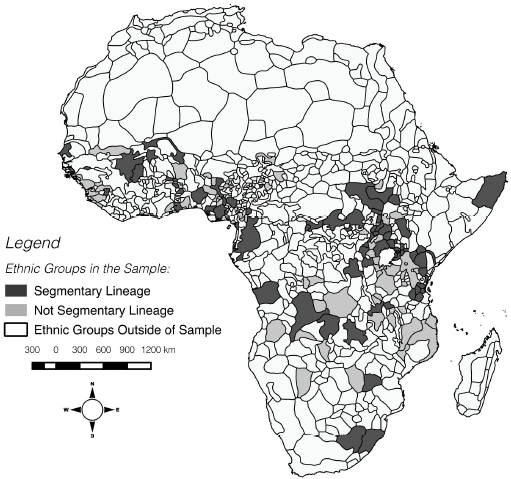
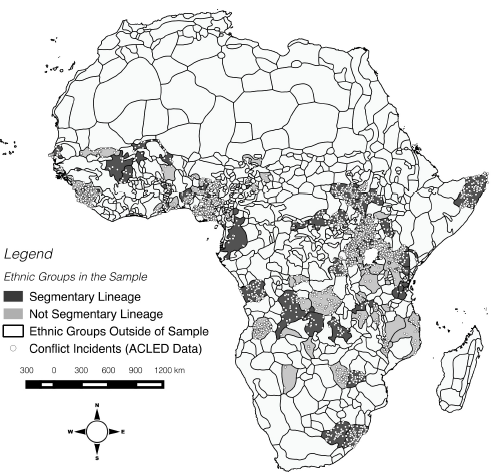
The baseline relationship between segmentary lineage organisation and violent conflict across ethnic groups today is shown in Figure 3. We find a quantitatively large and statistically significant relationship between segmentary lineage organisation and violent conflict, even after controlling for a broad range of observable geographic and historical characteristics. The estimated magnitudes are large. For example, we find that segmentary lineage societies experience 84% more deadly conflict incidents than societies without segmentary lineage organisation. The relationship looks very similar for other measures of conflict intensity or if we look specifically at conflicts that involve the government (civil wars), conflicts that do not involve the government, or conflicts in which both sides were local actors.
Figure 3
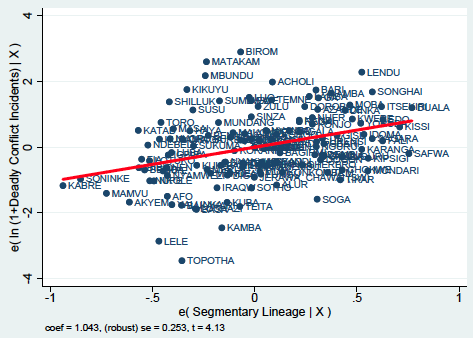
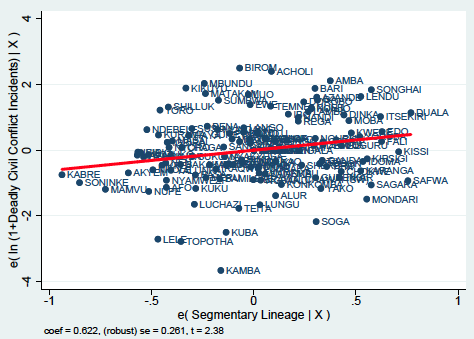
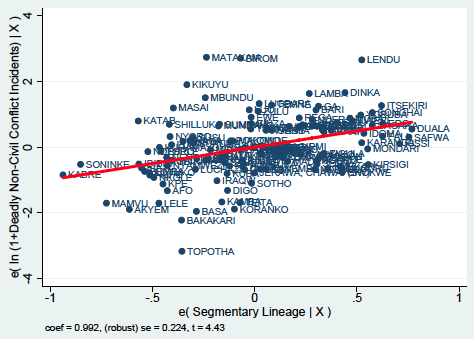
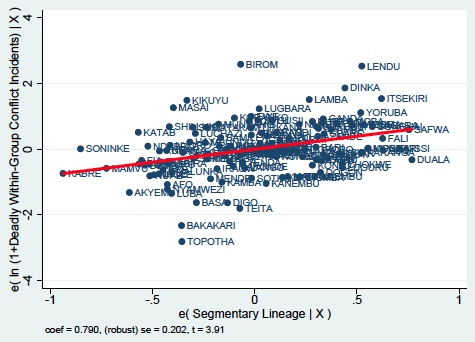
In order to investigate whether this relationship is causal, we undertake a second analysis focusing on conflicts near borders between segmentary lineage and non-segmentary lineage societies. By restricting our analysis to these conflicts, we can control flexibly for any unobservable characteristics that vary smoothly over space. Results from this regression discontinuity strategy are qualitatively very similar to the results from the cross-ethnicity analysis. The number, duration, and scale of armed conflict are all much greater in regions just inside the border of segmentary lineage societies than in regions just outside, even though these regions are likely very similar in terms of geography, historical experience, distance from major cities, and so on.
Mechanisms
Both the cross-ethnicity and the regression discontinuity results suggest a positive relationship between segmentary lineage organisation and conflict. However, this could be either because segmentary lineages cause existing conflicts to escalate and last longer, or because they result in more new conflicts, or a combination of the two. Case-study evidence points to the escalation mechanism – once a conflict begins, the lineage structure facilitates the mobilisation of additional combatants, making resolving the conflict less likely. We test for this channel empirically and find that segmentary lineage organisation has a strong positive effect on conflict duration and a positive, but weaker effect on conflict onset. We also find that, consistent with this, segmentary lineage organisation has the biggest effect on larger-scale conflicts that result in a high number of fatalities. Last, we find that adverse rainfall shocks, which have been shown to instigate conflict (Miguel et al. 2004), leads to significantly more conflict within segmentary lineage societies. Taken together, our empirical results are consistent with anthropological and historical evidence suggesting that segmentary lineage organisation escalates, exacerbates, and broadens the reach of violent conflict, including conflict spurred by rainfall shocks.
Broader implications
While our study focuses on Africa, its implications are not limited to the African context. Segmentary lineage organisation is also prevalent in the Middle East, where lineage segments facilitate the recruitment of terrorist combatants. For example, Osama bin Laden and many individuals recruited to Al Qaeda were and are Yemeni, which is a segmentary lineage society (Dresch 1989). In a recent speech, anthropologist Akbar Ahmed (2013b) argues for a link between segmentary lineage organisation and Islamist violence and terrorist recruitment:
“Here is a correlation for you. Ask yourselves: where are [US] drones most used? They are really segmentary lineage systems: the Pashtuns in Afghanistan and Pakistan tribal areas, mainly in Waziristan; among the Somali segmentary lineage system; the Yemenis’ segmentary lineage system; the Kurds in eastern Turkey…An immediate correlation…All of these are coming out of straight segmentary lineage system backgrounds.”
Thus, our findings have the potential to explain conflict outside of Africa, including conflicts with major and immediate policy relevance in the US. They raise the possibility that segmentary lineage organisation may be a crucial driver of global conflict.
References
Ahmed, A (2013a), The Thistle and the Drone: How America’s War on Terror Became a Global War on Tribal Islam, Washington, DC: Brookings Institution Press.
Ahmed, A (2013b), “Muslim tribes and the War on Terror”, Speech transcript, Chatham House, London.
Barth, F (1973), “Descent and marriage reconsidered”, in Jack Goody (ed), The Character of Kinship, Cambridge: Cambridge University Press: 3–19.
Bohannon, L (1958), “Political aspects of Tiv social organization”, in J Middleton and D Tait (eds), Tribes Without Rulers, London: Routledge Keegan & Paul: 33–67.
Dresch, P (1989), Tribes, Government and History in Yemen, New York: Oxford University Press.
Evans-Pritchard, E E (1940), The Nuer, Oxford: Clarendon.
Gennaioli, N and I Rainer (2007), “The modern impact of precolonial centralization in Africa”, Journal of Economic Growth 12(3): 185–234.
Kelly, R C (1985), The Nuer Conquest: The Structure and Development of an Expansionist System, Ann Arbor, MI: University of Michigan Press.
Lewis, I M (1961), A Pastoral Democracy, Oxford: Oxford University Press.
Lewis, I M (1989), “The Ogaden and the fragility of Somali segmentary nationalism”, African Affairs 88(353): 573–579.
Lewis, I M (1994), Blood and Bone: The Call of Kinship in Somali Society, Trenton: The Red Sea Press.
Michalopoulos, S and E Papaioannou (2013), “Precolonial ethnic institutions and contemporary African development”, Econometrica 81(1): 113–152.
Michalopoulos, S and E Papaioannou (2014), “National institutions and subnational development in Africa”, Quarterly Journal of Economics 129(1): 151–213.
Middleton, J and D Tait (1958), “Introduction,” in J Middleton and D Tait (eds), Tribes Without Rulers, London: Routledge Keegan & Paul: 1–32.
Miguel, E, S Satyanath and S Saiegh (2004), “Economic shocks and civil conflict: An instrumental variables approach”, Journal of Political Economy 112(4): 725–753.
Moscona, J, N Nunn and J A Robinson (2017), “Social structure and conflict: Evidence from sub-Saharan Africa”, Working Paper.
Murdock, G P (1959), Africa: Its Peoples and Their Cultural History, New York: McGraw-Hill Book Company.
Sahlins, M D (1961), “The segmentary lineage: An organization of predatory expansion”, American Anthropologist 63(2): 322–345.
Salzman, P C (2007), Culture and Conflict in the Middle East, New York: Prometheus Books.
Smith, M G (1956), “On segmentary lineage systems”, Journal of the Royal Anthropological Institute of Great Britain and Ireland 86(2): 39–80.
Endnotes
[1] The formal definition of segmentary lineage organisation consists of three components: (1) individuals trace their ancestry through either their maternal or their paternal line (but not both) and as a result, each individual has a one-dimensional measure of her relatedness to every other member of the ethnic group; (2) larger lineages have sub-sets (segments) which form the main social, political, and administrative units; and (3) lineages and genealogical relationships influence one’s location of residence (Middleton and Tait 1958).



